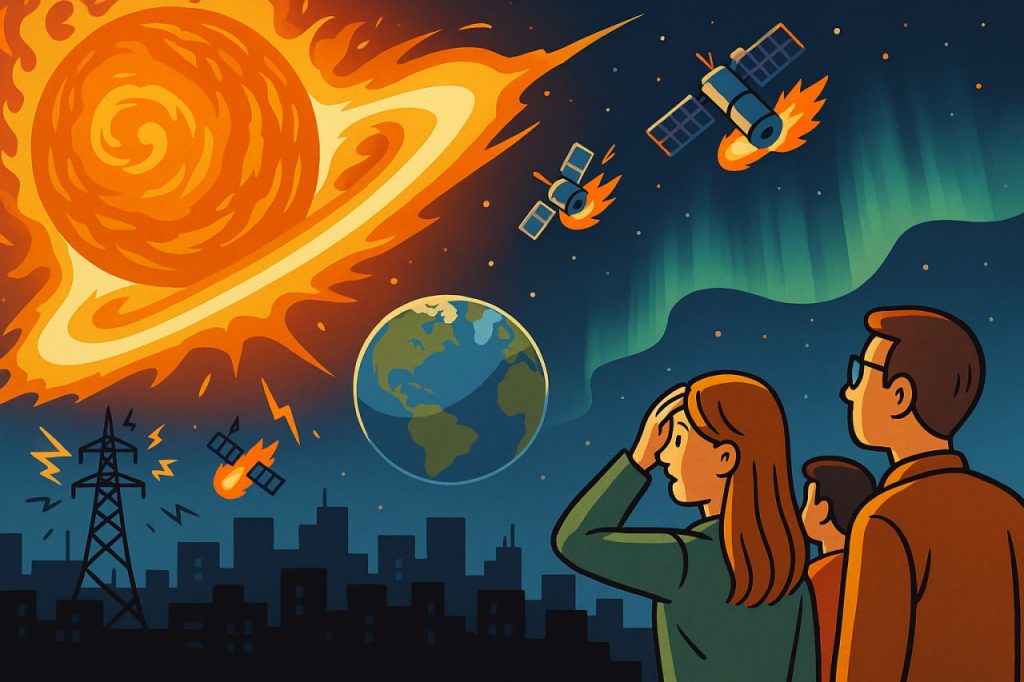Imagine waking up one morning to find that every electronic device — your phone, computer, car, and even the power grid — has suddenly stopped working. Planes can’t fly, satellites fall silent, and entire cities are plunged into darkness. This frightening scenario could become reality if a massive solar storm, also known as a coronal mass ejection (CME), were to hit Earth with enough force. Such an event would unleash electromagnetic chaos, potentially erasing decades of technological progress in a single day.
The Source of the Threat: Solar Activity
The Sun is not a calm star — it constantly emits radiation, magnetic fields, and streams of charged particles known as the solar wind. Occasionally, it erupts violently, throwing billions of tons of plasma into space at speeds exceeding 2 million kilometers per hour. When this eruption — a coronal mass ejection — collides with Earth’s magnetic field, it can generate intense geomagnetic storms capable of disrupting modern technology.
Earth’s magnetosphere usually protects us from most solar radiation. However, a sufficiently powerful CME could overload this natural shield, allowing massive surges of electromagnetic energy to reach the ground.
Historical Warnings
Humanity has already witnessed smaller versions of such events:
- The Carrington Event (1859): The most powerful solar storm in recorded history. Telegraph lines caught fire, and auroras were seen as far south as the Caribbean.
- The Quebec Blackout (1989): A geomagnetic storm knocked out power across Canada for nine hours, leaving millions without electricity.
- The Halloween Storms (2003): Satellite communications and flights were disrupted worldwide.
If a storm stronger than these were to strike today, its effects would be catastrophic — because modern society depends entirely on electronics.
Immediate Consequences of a Planetary Blackout
- Collapse of the Power Grid
Electric grids are extremely vulnerable. High-voltage transformers would burn out instantly, causing widespread and long-term blackouts. Repairing such infrastructure could take months or even years. - Loss of Communication and Navigation
Satellites would be destroyed or disabled, silencing GPS, the internet, and global communication networks. Air travel, maritime routes, and even emergency systems would fail. - Transportation Paralysis
Modern cars, trains, and airplanes rely on electronic control systems. Without them, transportation would halt almost entirely. Fuel pumps, controlled by digital systems, would stop working too. - Financial System Breakdown
Banks and stock exchanges would shut down instantly, as all records, data centers, and ATMs depend on electricity and the internet. Digital currencies would vanish, and even paper money would quickly lose value in a barter-based society. - Medical and Food Crises
Hospitals would lose power for critical equipment, while refrigeration systems for medicine and food would fail. Water supply systems, which rely on electric pumps, could stop, leading to dehydration and disease outbreaks.
The Long-Term Aftermath
If the damage were global, humanity would essentially revert to a pre-industrial state. Recovery would be slow because most manufacturing equipment and data storage systems would be destroyed. Rebuilding would require not only physical infrastructure but also knowledge stored in now-unreadable digital archives.
Governments would likely declare states of emergency, prioritizing survival essentials like water, food, and energy production. Cooperation between nations would become vital, as no single country could rebuild alone.
Could We Prevent Such a Disaster?
Scientists are monitoring solar activity through satellites such as SOHO (Solar and Heliospheric Observatory) and Parker Solar Probe, which detect CMEs early. This gives Earth a warning time of 12 to 48 hours — barely enough to shut down grids and protect satellites.
Protective solutions include:
- Hardened transformers and grounded cables to resist geomagnetic surges.
- Faraday cages to shield critical systems.
- Space weather forecasting centers, similar to meteorological agencies, that warn power companies and governments.
Unfortunately, full protection is impossible — we can only minimize damage, not eliminate it.
How Humanity Could Adapt
If such an event occurred, recovery would depend on rebuilding low-tech systems and prioritizing renewable, decentralized energy sources such as solar and wind power (ironically powered by the same Sun that caused the catastrophe).
The crisis could push humanity toward more sustainable, resilient technologies — but only after a period of deep hardship and global cooperation.
Interesting Facts
- The energy released during a large CME equals billions of nuclear bombs.
- The Sun follows an 11-year activity cycle, with solar storms more likely during peak periods.
- A Carrington-sized event today could cause over $2 trillion in damage in the first year alone.
- Some scientists suggest burying backup electronics underground to shield them from electromagnetic pulses.
- Auroras during a superstorm would be visible even at the equator.
Glossary
- Coronal Mass Ejection (CME) — a massive burst of solar plasma and magnetic field from the Sun.
- Geomagnetic Storm — a disturbance in Earth’s magnetic field caused by solar activity.
- Electromagnetic Pulse (EMP) — a burst of electromagnetic energy that can disable electronics.
- Faraday Cage — a structure that blocks electromagnetic fields, protecting sensitive equipment.
- Magnetosphere — the magnetic field surrounding Earth that shields it from solar wind.


